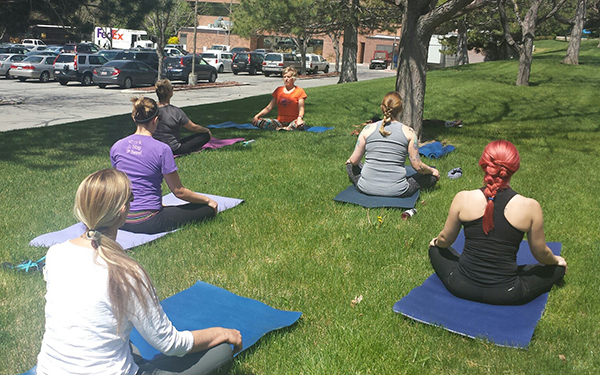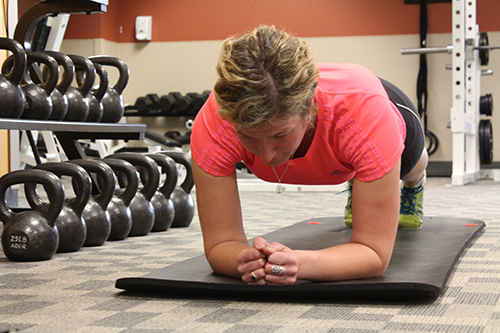Decreasing Healthcare Costs by “Triaging” Your Company

“We both agreed something had to change. We felt awful, looked awful, and knew we were facing a train head on if we didn’t do something about our health,” says Carolyn Werrett, recalling when she and her husband, Andy, received the results of their annual personal health profile (PHP)—an analysis of personalized health risks. ARUP employees who want to pay lower medical insurance premiums must complete the PHP every year.
Carolyn had high cholesterol and a history of stroke, and Andy was on the verge of diabetes. Being overweight exacerbated their health problems.
By the next PHP appointment 18 months later, Carolyn had lost 55 lbs. and Andy 110 lbs. No longer were diabetes, stroke, and heart attacks a concern. Certain medications became unnecessary, as did visits to specialists. Soon, Andy will no longer need to rent his CPAP machine for sleep apnea. Aside from living healthier, happier lives, the Werretts, as well as ARUP, have saved thousands of dollars in healthcare expenses.
The Werretts improved health ripples throughout their lives. They took their first hiking trip to Zion National Park last spring and walk with their dogs almost daily. “It’s amazing how much more we move because it doesn’t hurt. We feel good,” says Carolyn. She adds that with her new well-being has come renewed confidence, which is why she recently pursued a new position within ARUP. “I would never have done that a year ago.”
Identifying the High-Risk Populations
Utilizing data from PHPs, ARUP Family Health Clinic Director Peter Weir, MD, and his staff have been able to identify high-risk patients and track their health trends. Some 95 percent of ARUP employees participate in the PHP program, partly because completing the PHP can save them up to 50 percent off their health premiums.
In 2011, when ARUP launched the PHP, 250 people were identified as having diabetes (type I and type II); more than 20 of those were not aware that they had the disease.
Diabetes is one of the six chronic diseases dubbed “most common, costly, and preventable of all health problems” by the Center for Disease Control and Prevention (CDC). These chronic diseases account for two-thirds of the healthcare costs in the country.
According to the CDC, as of 2012, about half of all adults—117 million people—have one or more chronic health conditions. One in four adults has two or more chronic health conditions.
Well aware of the steep costs, Weir and his staff approached the patients identified as having diabetes with the promise that if they allowed the onsite ARUP Family Health Clinic to manage their condition, they would receive their medication, including insulin and diabetic supplies, at no cost and receive the best possible care.
The PHP has allowed us to create a chronic disease care model that reduces the costs for everyone, including the patient.
After hiring a clinical pharmacist, RN care manager, and certified diabetic educator, Weir was certain he could keep his promise.
Currently, nearly all ARUP employees and family members who have been diagnosed with diabetes use the health clinic to manage their condition—results that have yet to be matched at any other organization, according to Weir.
“Our PHP is about triaging the entire company to define people’s risks of chronic diseases with a particular focus on cardiovascular health,” explains Weir, who uses PHP data to create chronic disease registries for, among others, diabetes, heart disease, and asthma.
“We use a healthcare team to proactively find high-risk individuals, draw them into the clinic, and plug them into our wellness program,” adds Weir. These individuals receive routine primary care visits with ARUP’s medical providers and have access to a clinical pharmacist and one-onone health coaching with the wellness staff.
Weir notes that many of these patients want help with improving their health because they fear not being around for their children or grandchildren.
What Happens in the Clinic Stays in the Clinic

To ensure the health privacy of employees, ARUP has created a strict wall of confidentiality between Human Resources and the health clinic. “Essentially, when you walk into the clinic, you are at a different company,” says David Jackson, senior vice president, strategic services. Some of the privacy measures include:
- All healthcare records are stored and accessed from Epic, the University of Utah electronic medical record system. This information can be accessed only by the clinic’s staff and is not accessible by any other IT systems at ARUP, including human resources.
- ARUP performs routine HIPAA privacy audits.
- The insurance company that administers ARUP’s self-insurance program has no access to clinic data.
Intuitively It Made Sense
More than 20 years ago, ARUP Laboratories took a proactive approach to rising healthcare costs by adopting a self-insured approach, minus any thirdparty providers. “After a certain size, we decided to be the risk takers,” says David Jackson, senior vice president, Strategic Services.
The onsite ARUP clinic was originally established in 1992. At the time, the clinic was staffed with one physician assistant and intended only for urgent care and workers’ compensation claims for some 500 employees. ARUP significantly expanded the clinic in 2009 to care for nearly 3,000 employees and their families—approximately 6,500 people.We figure out what is best adapt it to their needs and schedules. We’re able to develop a relationship with each person and create accountability. That drives improvement in health
“We decided to take a run at being a population-based health clinic because intuitively we knew it made sense. Financially it made sense because our employees could get back to work much quicker when they had medical appointments,” recalls Jackson, noting the clinic had not initially price-coded patient visits, making it difficult to compare costs against other providers. “We figured if we could do it right, we could do it for less.”
Within four years the company saw healthcare costs remain flat in a national setting where on average companies saw a 7 percent increase in healthcare costs per year. Pleasantly surprised, ARUP executives gave Weir the go-ahead to further expand the clinic’s staff and services.
Today, the health clinic is staffed with seven medical providers (two physicians and five mid-level providers), along with a mental health therapist, clinical pharmacist, nutritionist, and nurse case manager. The clinic averages more than 25,000 patient visits per year. ARUP healthcare costs are still below the rising national rates.
Weir, a big believer in full-spectrum primary care, has linked the medical care of patients with the onsite wellness program that includes one-on-one health coaching and fitness training. In collaboration with the medical providers, the three certified wellness coaches set individualized goals for each patient. For example, in the Werretts’ case, the clinic staff wanted to see them on a monthly basis to monitor their health and encourage their progress. Carolyn worked with one of ARUP’s wellness coaches to become more physically fit.
“We figure out what is best for our employees and adapt it to their needs and schedules. We’re able to develop a relationship with each person and create accountability. That drives improvement in health,” says Wellness Coach Seth Bigelow, who notes that those who use all three areas of the health benefits offered—physical, mental, and medical—get the best results.
Quantifying the Savings

While there is an abundance of anecdotal feedback on lives changed (and saved) by this program, Weir cites a 2014 study done on PepsiCo’s wellness program that concludes disease-management programs have a good return on investment, with $3.78 saved for every dollar invested in the case of PepsiCo. In this study, what drove the biggest reduction in healthcare costs was a 29 percent reduction in hospital admissions, as even one hospital visit can stretch into tens of thousands of dollars.
“The PHP has allowed us to create a chronic disease care model that reduces the costs for everyone, including the patient,” says Weir.
“Work-site clinics” are a growing movement nationally; ARUP was ahead of the game launching its clinic more than 20 years ago. Near future plans include collaborating more closely with the University of Utah medical center (see sidebar) and providing support/education groups for patients with common diagnosis, like diabetes.
“As far as we know, ARUP operates one of the largest onsite clinics in the state. There is nothing secret or special about what we are doing. What makes the model successful is that it is a win-win for the company and its population,” says Weir, who accommodates visits from others around the country interested in modeling ARUP’s healthcare program. “Our focus is squarely on improving the health of ARUP employees and their families. That helps patients and, as it turns out, reduces the company’s healthcare costs too.”
The Business of Caring: Collaborations That Save Money
You’re experiencing heart pangs and let your primary care provider (PCP) know. She knows you already have a stent in your coronary artery and wonders if you may need a stress test to help determine if there is evidence of an abnormal rhythm or ischemia (not enough blood flow to the heart muscle).
Your PCP can either refer you to a cardiologist (approximately a $250 visit) or send your physical exam and EKG results to the cardiologist who, over the phone, can discuss and determine with your PCP whether you need a stress test or not. If you need one, the cardiologist agrees to see you; if you don’t need one, you can leave free of concern.
This approach using e-consultation is steadily being built into ARUP’s health clinic’s model. It is happening already with the University of Utah’s Department of Psychiatry and being explored as an option with several other departments. Such collaboration allows for quicker and less fragmented care for patients and supports referrals to specialists for more complex conditions. It also saves money for patients and the health-insurance provider, which is ARUP in this case.
Decreasing Pediatric ER Visits for Asthma Attacks
Another collaboration aims to decrease expensive pediatric emergency room (ER) visits for asthma attacks. The ARUP Family Health Clinic and Primary Children’s Medical Center (PCMC) partnered this past summer on the E-Asthma Project. Parents at ARUP who have children with asthma complete a weekly, online questionnaire via a PCMC portal website.
This information then flows to a care manager at the family clinic who looks for any red flags (e.g., wheezing more than usual, lethargy) and then checks in with parents to solve the issue, which may be as simple as needing a new prescription for an inhaler or a different dosage. In a PCMC study, this approach significantly decreased ER visits.

















 HOME
HOME